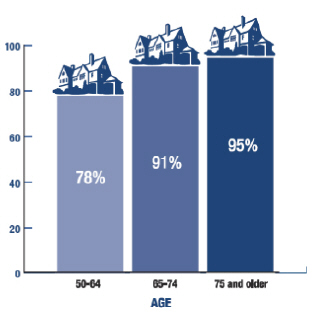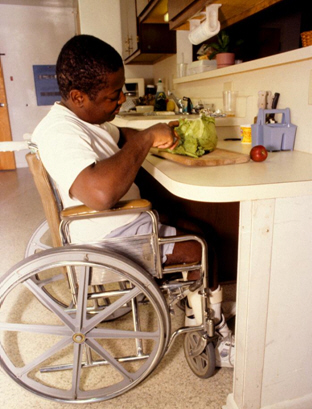Household Tips for Aging in Place

AARP says the vast majority of Americans over age 50 want to stay in their homes as they age. We’d rather stay in familiar surroundings with treasured memories and nearby friends and neighbors than seek assisted living and other options. Most homes, however, weren’t designed with that objective in mind. Often built by and for younger generations, they can pose hazards to someone with impaired mobility, balance or vision. Fortunately, some relatively inexpensive adaptations can accommodate life changes as we age. This article addresses the simplest of them.
Safety & Mobility
As we get older, or suffer an injury or other disability, our sore joints, weakened muscles, and a lack of balance, dexterity and vision make simple tasks difficult, including reaching, bending, lifting, and moving about more. This can contribute to accidents and affect our personal hygiene, nutrition, and well-being.
So remember what Benjamin Franklin said, “An ounce of prevention is worth a pound of cure.” With planning and preparation, you can help prevent falls and injuries rather than react to them.
- Rugs. Remove loose rugs since they’re a primary cause of falls and broken bones.
- Rockers and unstable furniture. Replace them since seniors may use them to steady themselves.
- Pill Dispensers. The medication regimen can get complex with multiple conditions occurring simultaneously, especially for seniors. Simple pill dispensers can helps, but also consider monitored dispensers ($160 install, $15-$35/month monitoring).
- Monitored Alarm. Personal emergency response systems (PERS – $50 install, $15-35/month monitoring) provide a wearable pushbutton for summoning help. They are often available as accessories to existing monitored home security systems.
- Cordless Phones. They can be put in any room or every room, but look for models that are easy to use.
- Mobile Smart Phones. Having phone access away from home is a safety issue, but rather than look for the simple models with big buttons for seniors, consider smart phones and benefit of apps designed for seniors. (more on this in a future article)
- Bathroom. Install a seat in the shower, even a portable one, and add a hand-held showerhead. Install grab bars in the shower and bath (~$250). Install a higher commode and handrails. Complete bathroom remodels, including replacing a tub with a walk-in shower and replacing faucet handles, can cost $3,500 to $35,000.
- Stairs & steps. Make sure all stairs and outside steps have handrails, and consider replacing or covering steps with ramps ($1,600-$3,200). Home entryways that don’t need stairs serve not only wheelchair access but also baby strollers and wheeled suitcases.
- Stair Lift. If your two-story home lacks a bedroom and full bath downstairs and you can’t remodel, then consider a stair lift ($3,000-$12,000). They can be purchased or rented, and you can often find good refurbished models.
- Doorways. Remove doors that serve no useful purpose and widen doorways ($800-$1,200) so people can get around with canes, walkers or wheelchairs.

Comfort & Convenience
- De-clutter & Reorganize. Clean house and discard everything that’s not truly needed, remembering to reuse (donate) and recycle where possible. Organize the things that remain so objects used daily are within easy reach.
- Lighten up. Replace heavy pots, pans, vacuums, and trash cans with lightweight models
- See the Light. Bright lighting is important to people with poor eyesight, so replace existing light bulbs with the new fluorescent variety. They not only save energy, but they last so much longer.
- Remote Control. Just like a universal remote is used to control the TV and cable box, handheld wireless devices are available to control lights, window blinds, and fans – all while seated or from the bedside.
- Friendly Furniture. Consider adjustable beds and chairs that recline easily, but avoid cushiony furniture that’s had to get in and out of.
- Stay Warm. Senior can get cold when not moving around, so cut the chills with attic insulation and weather stripping to eliminating drafts.
- Remodel. The National Association of Home Builders has a Certified Aging-in-Place program to teach contractors about remodeling for aging-in-place, but be sure to check out your contractor. Many states, including Texas, have laws that shield builders and contractors from accountability. Add up the total costs of adding a room downstairs, remodeling a bathroom, or reconfiguring cabinets and counters to add knee space and pull-out shelves. You may find that remodeling ismore expensive than moving.
- Appropriate Appliances. Front-loaded appliances are easy for someone in a wheelchair to use. Top-loaded models are not.
- Do Your Chores. In addition to any professional medical help that’s needed, consider the relatively inexpensive cost of weekly maid service, lawn care, and Meals on Wheels.
- Save Money and the Environment. Purchase wisely, buy second hand, recycle, and donate.
Add your own suggestions below. Check out the MetLife Aging in Place Workbook. And watch for more from me in follow-on articles.

Here’s an expanded list: http://www.therapytimes.com/Home_Safe_Home_Fostering_aging_in_place_patterns_through_home_modification_asses/content=1102J84C487E5A84404040441